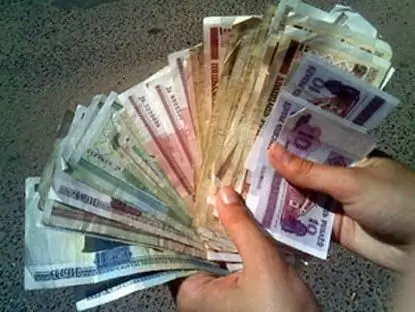2026 Author: Howard Calhoun | [email protected]. Last modified: 2025-01-24 13:10:45
Malaysia is a country in southeastern Asia. It occupies part of the Malay Peninsula and the island of Borneo. The capital of Malaysia is Kuala Lumpur.
At different times, the official currency of Malaysia had different names. This is due to the different historical conditions for the development of the country's economy. Since 1975, it has been called ringgit. This word itself is an outdated concept, which is translated from the Malay language as "toothed". The term was originally used for the scalloped edges of silver Spanish dollars. The Malaysian currency symbol is RM, the currency code is MYR, and the ringgit itself is subdivided into 100 units (cents). The denominations used are 5, 10, 20, 50 sen for coins and RM1, RM5, RM10, RM20, RM50, RM100 for banknotes.
History of Malaysian money
Since the 16th century, Malaysia, then part of the European colonial powers, has used Spanish dollars. In 1837, the Spanish silver dollar was replaced by the Indian rupee. In 1903, a new one appeared in Malaysia, which corresponded to two shillings. British pound sterling. It wasn't until 1967 that the central bank - "Bank Negara Malaysia" - introduced the ringgit, which was originally billed as the Malaysian dollar. Prior to this date, the official currency was the dollar, which was also used by Singapore and Brunei.

Appearance of new Malaysian money
When the ringgit replaced the Malaya and British Borneo dollar at its face value, it retained all of its predecessor's denominations except for the $10,000 denomination. In addition, similar color schemes were even used. Malaysia's new money, which was originally pegged at $8.57 instead of the British pound, was not affected by the devaluation of the pound a few months later, while the old banknotes, still pegged to the British pound, fell in value to 85 cents per dollar.
In 1968 $1000 notes were introduced and it was the first banknote to feature Tuanku Abdul Rahman, Malaysia's first Yang di Pertuan Agong (elective monarch) and the signature of Tun Ismail bin Mohamed Ali, the first head of Bank Negara Malaysia (Central Bank of Malaysia).

Formal adoption
The money fungibility agreement linking three countries (Malaysia, Singapore and Brunei) meant that the Malaysian dollar was exchanged on par with the Singapore dollar and the dollar in Brunei. When Malaysia left the monetary union in 1973, the value of the new currency was no longerfungible for Singapore or Brunei money. Shortly thereafter, in 1975, the Malay names "ringgit" and "sen" were adopted as official. However, the "RM" symbol was introduced much later, in 1993, to replace the dollar sign, or "$".
Due to low demand, Malaysian 1 ringgit banknotes were no longer printed and were replaced by RM1 coins in 1993. In 1996, Malaysia stepped up anti-counterfeiting measures by adding an additional hologram to the larger RM50 and RM100 banknotes.

1997 Asian financial crisis
When the Asian financial crisis hit Malaysia in 1997, a lot of money was taken out of the country. As a result, the RM500 and RM1000 notes were discontinued and they ceased to be legal tender in 1999. To avoid fluctuations in the local currency after the crisis, the Central Bank, in order to protect the money of Malaysia, used a "dirty floating" rate.
This regime continued until July 1997, when Bank Negara Malaysia refused to maintain the ringgit exchange rate after the Asian crisis. Since September 2, 1998, for the purpose of stabilization, it has been pegged to the US dollar at $1=RM3, 8010.
Currently, the Malaysian ringgit rate against the dollar is 4.16 ringgit per $1. At the same time, this monetary unit is rather unstable. The dynamics of change is due to various factors. In particular, this can be traced by how the exchange rate has changed over the past year. Malaysian ringgit to ruble.
Changes in turnover
In 2004, Bank Negara Malaysia released a new RM10 banknote with additional security features, including a holographic strip previously only used on the RM50 and RM100 banknotes. A new banknote with a transparent window was also issued. Due to low demand for coins, the 1 ringgit coins were withdrawn from circulation in 2005. This was also done to prevent counterfeiting and ensure the standardization of this coin (two different versions of the second series coin were issued). At the beginning of 2008, the Bank issued a new RM50 banknote.

Coins
The minting of small money in Malaysia consisted of three stages. The first stage took place in 1967, when coins were introduced in denominations of 1, 5, 10, 20 and 50 sen. A 1 ringgit coin was introduced and distributed four years later. They were made of copper-nickel alloy and featured the national flag of Malaysia.
The second series of coins was designed by Low Y Keng and released in 1989. Their design was completely different from those previously made. They were made from an alloy of copper, zinc and tin. They featured images of items that represented Malaysian culture. Most of the coins issued in these two series are no longer in circulation.
The third series of coins was minted at the Bank Negara Mint and was supplied by South Korea's Poogsan Corporation as a directive of Deputy Finance Minister Datuk Donald in 2011. At this time they used5, 10, 20 and 50 sen coins.

Banknotes
They were produced in Malaysia in four series. In the first series in 1967, banknotes were issued in denominations of 1, 5, 10, 50, 100 and 1000 dollars. Many years later, in 1993, the second series included the replacement of the one dollar note with a coin. In 1999, the Malaysian ringgit in denominations of RM 500 and RM 1000 was discontinued.
In the third series, the designs of the issued banknotes were created in accordance with the vision of Malaysia as an independent industrial state, which it should become by 2020. These banknotes are currently in use and are designated RM1, RM5, RM10, RM20, RM50 and RM100.
RM50 is the only banknote that stands out from the rest as it was issued to commemorate the Commonwe alth Games held in Malaysia in 1998.

Interesting facts
Sometimes the Malays themselves still call their money a dollar. Therefore, when talking, you can often hear the price, for example, ten dollars, which in fact will mean ten ringgits of Malaysia. At the same time, local residents do not consider this a mistake.
Until now, the old 1 sen coin remains in circulation.
In 2008, a rounding mechanism was introduced (when the prices in the general account of any purchase were rounded up to the nearest 5 sen) as a measure to eliminate the coin from circulation on 1 sen.
However, despite this, these coins, as well as those in denominations of 1 ringgit, are stillused as legal tender, but only for payments not exceeding two ringgits. Although the seller will probably be angry and may even refuse to accept this money. So it might be better to exchange them at the nearest bank.
New Malaysian money has a new signature of the head of Bank Negara Malaysia. They bear the signature of Zeti Aziz, it belongs to the former head of Bank Negara, who held this position for 16 years. This term is only the second longest after Tun Ismail Mohd Ali, who served 18 years from 1962 to 1980, although the average tenure is about five years.
The current exchange rate of the Malaysian ringgit to the ruble is 15.76 rubles for 1 MYR.
Recommended:
Make money on the Internet on assignments: ideas and options for earning money, tips and tricks, reviews

There are a lot of ways to make money on the Internet without investments and deception. But where and how much can you earn online? Is it necessary to create your own website? How to get the first profit? What tasks need to be completed in order to receive income, and how to withdraw money?
How to make money without money? Ways to make money. How to earn real money in the game

Today everyone can make good money. To do this, you need to have free time, desire, and also a little patience, because not everything will work out the first time. Many are interested in the question: "How to make money without money?" It's a perfectly natural desire. After all, not everyone wants to invest their money, if any, in, say, the Internet. This is a risk, and quite a big one. Let's deal with this issue and consider the main ways to make money online without vlo
The dollar and the euro are showing strong growth. Why is the euro and dollar rising in 2014?

To understand why the euro and the dollar are growing, and the Russian ruble is falling, you should analyze the political and economic situation in the world
Cross rates are an important tool. Cross-rate of euro, dollar and ruble

Cross-rates are a phenomenon that belongs to the category of currency exchange operations, which has become widespread in Forex. Interestingly, this phenomenon involves transactions with currency pairs in which the dollar does not appear as a base or priority currency
Devaluation of the Belarusian ruble in 2015. What is the devaluation of the Belarusian ruble and how does it threaten the population?

The devaluation of the Belarusian ruble in 2015 will have very serious consequences for the population. The crisis can cover not only the real sectors of the economy, but also the banking sector, real estate

